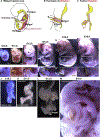Signals and forces shaping organogenesis of the small intestine
- PMID: 30797512
- PMCID: PMC12359083
- DOI: 10.1016/bs.ctdb.2018.12.001
Signals and forces shaping organogenesis of the small intestine
Abstract
The adult gastrointestinal tract (GI) is a series of connected organs (esophagus, stomach, small intestine, colon) that develop via progressive regional specification of a continuous tubular embryonic organ anlage. This chapter focuses on organogenesis of the small intestine. The intestine arises by folding of a flat sheet of endodermal cells into a tube of highly proliferative pseudostratified cells. Dramatic elongation of this tube is driven by rapid epithelial proliferation. Then, epithelial-mesenchymal crosstalk and physical forces drive a stepwise cascade that results in convolution of the tubular surface into finger-like projections called villi. Concomitant with villus formation, a sharp epithelial transcriptional boundary is defined between stomach and intestine. Finally, flask-like depressions called crypts are established to house the intestinal stem cells needed throughout life for epithelial renewal. New insights into these events are being provided by in vitro organoid systems, which hold promise for future regenerative engineering of the small intestine.
Keywords: Boundary formation; Crypt development; Epithelial-mesenchymal crosstalk; Intestinal lengthening; Intestinal organoids; Intestinal regionalization; Mesenchymal clusters; Signaling cascades; Tensile forces driving morphogenesis; Villus development.
© 2019 Elsevier Inc. All rights reserved.
Figures






References
-
- Applegate KE, Anderson JM, & Klatte EC (2006). Intestinal malrotation in children: A problem-solving approach to the upper gastrointestinal series. Radiographics, 26, 1485–1500. - PubMed
-
- Arnaout R, & Stainier DYR (2011). Developmental biology: Physics adds a twist to gut looping. Current Biology, 21, R854–R857. - PubMed
-
- Barker N, Huch M, Kujala P, van de Wetering M, Snippert HJ, van Es JH, et al. (2010). Lgr5(+ve) stem cells drive self-renewal in the stomach and build long-lived gastric units in vitro. Cell Stem Cell, 6, 25–36. - PubMed
Publication types
MeSH terms
Grants and funding
LinkOut - more resources
Full Text Sources

